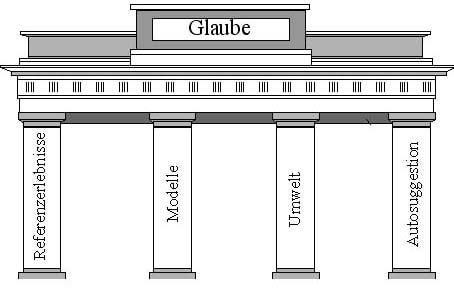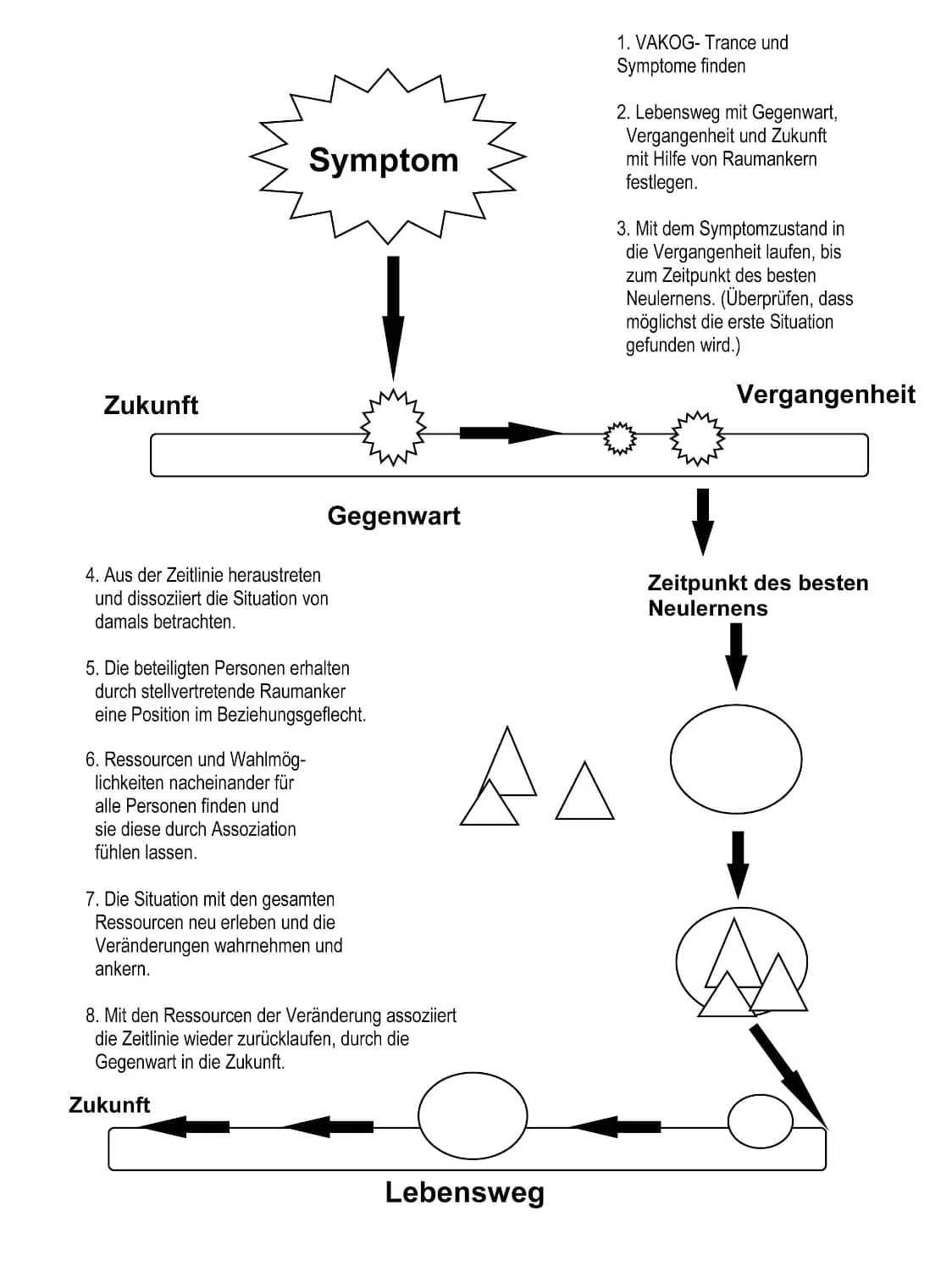Beliefs
A belief is a linguistic expression of something a person holds to be true. In NLP, beliefs are expressions of inner models that each person continually creates and must create to orient themselves in the world. Other terms for this include: convictions, attitudes, beliefs, opinions.

Table of Contents
- What are Beliefs?
- Examples of Limiting Beliefs
- Examples of Positive and Negative Beliefs
- How Beliefs Influence Our Life
- Consequences of Beliefs
- How a Belief Is Formed
- Finding Beliefs
- How Can Beliefs Be Changed?
- Techniques for Changing Beliefs
What Are Beliefs? Definition
Beliefs are generalizations (generalizations) about the “relationships between experiences.”
Beliefs are generalizations about:
- Connections / Causes
“It runs in the family.” - Meaning
“Smoking means weakness.” - Limits
“That’s impossible.”
And in relation to:
- The world around us
“You can’t concentrate in a noisy place.” - Specific behaviors
“You shouldn’t do that.” - Abilities
“I’ll never learn that.” - Our identity
“I’m competent in my job.” - Spirituality
“The universe is a friendly place.”
Beliefs guide the focus of our attention and determine which information we absorb and how we interpret it.
Beliefs form the overarching framework of all change work you do. When people truly believe they cannot do something, they will unconsciously find a way to prevent change from happening. They will interpret results in a way that fits their existing beliefs.
We all have convictions, attitudes, expectations, and beliefs — some inherited from culture and society, others derived from personal experience, adopted from others, generated by past trauma, or generalized through repetition.
The American sociologist W.I. Thomas was among the first to express the now widely accepted view that reality, in its consequences, is as people perceive and define it. This means: the way I construct my world and imagine it directly influences my actions and behavior.
Everyone has systems of beliefs or convictions closely linked with personal values and criteria that can strongly influence motivation, decision-making, and performance. They shape life drive, stress management abilities, and enable the creation of positive life plans, goals, and needs.
Belief systems consist of multiple beliefs that support and reinforce one another.
"Believe in your limits and they’re yours."
"What a person believes, they can achieve."
"All personal breakthroughs begin with a change in our belief systems."
Anthony Robbins
Beliefs – What Are They? Explained by Stephan Landsiedel
Examples of Limiting Beliefs
Below you will find some of the most common limiting beliefs along with facts and examples that may make you think differently.
“I’m too young.”
- Boris Becker won Wimbledon for the first time at age 17.
- At just 12, David Stuart gave a scientific lecture to 150 archaeologists and Mayan researchers about a hieroglyph he had deciphered.
- At 15, Judit Polgar became the youngest chess grandmaster of all time.
“I’m too old.”
- Hulda Crooks had no idea at 60 that she would discover mountain climbing as a new hobby at 70. By 90, she became the oldest woman ever to climb Mount Fuji.
- Livy wrote the history of Rome at 75, and Goethe completed "Faust" at 80.
- George Bernard Shaw broke his leg at 96 while picking plums from a tree.
“I don’t have enough education.”
- About 80% of the most successful entrepreneurs neither graduated from high school nor completed university.
- Albert Einstein never earned a high school diploma. He failed his first entrance exam at the Swiss Federal Polytechnic, yet went on to formulate the theory of relativity and became the most famous physicist of the 20th century.
- No one is stopping you from starting a new education today.
“I don’t have enough money.”
- Robert Schuller, known as the master of possibility thinking, had no money. Without a dollar, he founded a congregation, held services at a drive-in theater, and eventually built the Crystal Cathedral, now worth over 100 million dollars.
- Andrew Carnegie started in a spool factory earning 15 DM per week. In the last 18 years of his life, he donated over 1 billion DM.
“I lack the ability...”
- Robert W. Woodruff suffered from dyslexia and could barely read. Even as a major businessman, he had to sound out each word individually. Despite that, he led the Coca-Cola Company in Atlanta until his death in 1985, turning it into one of the world’s most successful corporations. If Robert Woodruff could do that, what’s stopping you from succeeding?
“I come from humble beginnings.”
- Arnold Schwarzenegger came from modest origins, yet became the most successful bodybuilder of all time, a Hollywood star, and even married into the Kennedy family.
“My physical disabilities prevent me from being successful.”
- Demosthenes stuttered and yet became the greatest orator of ancient Greece.
- The blind musician José Feliciano earned 38 gold records.
- The blind Stevie Wonder became world-famous.
- Despite his drooping eyelid and slow speech, Sylvester Stallone became one of Hollywood’s biggest stars.
Examples of Positive and Negative Beliefs
Money
| Positive | Negative |
|---|---|
| I attract money effortlessly like a magnet. | I need a lot of money to be happy. |
| I feel rich and successful. I am rich and successful. | Rich people gained their wealth through lies and deceit. |
| I love money and feel good about having plenty of it. | Without money, I’m worthless. |
| I deserve wealth and prosperity. | People envy me for my success. |
Self-Worth
| Positive | Negative |
|---|---|
| I accept myself as I am. | I’m a failure and good for nothing. |
| I am grateful for what I have. | Everyone else is better than me and reaches their goals — unlike me. |
| I’m a wonderful person. | I’m insignificant. |
| As I am, I am valuable, complete, and happy. | I can’t handle it all. |
| My opinion matters. | If I make a mistake or fail, I’ll be rejected. |
Weight Loss
| Positive | Negative |
|---|---|
| Living and eating healthily is fun for me. | Losing weight is too hard. |
| I’m allowed to be slim. | I’ll never stick to a diet. |
| I feel comfortable in my body. | Everyone in my family is overweight. |
| I allow myself to be slim and proud of it. | I just have bad genes. |
| I reduce and maintain my weight with ease. | No matter what I eat, I gain weight anyway. |
| My body naturally finds the weight that’s right for me. | If I want to lose weight, I have to deprive myself. |
Love
| Positive | Negative |
|---|---|
| I’m worthy of love. | No one loves me. |
| I’m surrounded by people who love me. | I’m alone. |
| Love and harmony fill my life. | No one wants me. |
| My family gives me love and affection. | I don’t deserve love and affection. |
| I live in love and harmony with my dream partner. | My relationships are doomed to fail. |
| There’s an infinite source of love flowing within me. | Other people don’t love or respect me. |
Health
| Positive | Negative |
|---|---|
| Being healthy is my body’s natural state. | My illness is incurable. |
| I feel healthy and fit. | I can never be completely healthy. |
| I have control over my own health. | My age is to blame for my condition. |
| Each breath fills me with new, healthy energy. | If I were fully healthy, no one would care about me anymore. |
| I choose a conscious, healthy lifestyle. | There’s no help for me anymore. |
Disability
| Positive | Negative |
|---|---|
| I’m unique and special. | I’m unattractive. |
| Despite my limitations, I can achieve anything I want. | I’m disadvantaged and have no chance compared to others. |
| I love and accept myself just the way I am. | My limitation keeps me from achieving my goals. |
Relationships
| Positive | Negative |
|---|---|
| My relationships are full of love and affection. | I’m incapable of having relationships. |
| I have a great partner by my side. | I feel restricted in relationships. |
| I enjoy my relationships to the fullest. | Relationships can never be easy or harmonious. |
| I’ll find the right partner for me. | It’s normal to fight a lot in a relationship. |
| My relationship gives me security and stability. | My partner doesn’t respect me. |
| I respect and love my partner as they are. | I can’t be happy in a relationship. |
How Beliefs Influence Our Life
Belief influences our physical functions — the body reacts as if what the mind believes were true. Furthermore, your behavior is also strongly shaped by your convictions and beliefs. Once a belief has been firmly anchored, even massive opposing information won’t shake it. We either ignore it or consider it wrong. The mechanisms of generalization, deletion, and distortion serve this purpose well. Some people even feel compelled to change the entire world just to make their belief right.
Examples
-
The Corpse
A classic example is the story of a man who believes he’s dead. He just sits and insists he’s a corpse. A psychiatrist argues with him for a while about whether he’s actually dead. Then the psychiatrist gets an idea.
He asks the man whether corpses can bleed. Since all bodily functions have stopped in a corpse, the man says no. The psychiatrist then pricks his finger with a needle. When blood appears, the man says: “Oh, I must have been mistaken. Corpses can bleed after all.” -
Cancer Study
In an interesting study, a researcher interviewed 100 “cancer survivors” to discover what they all had in common. She defined a survivor as someone diagnosed with terminal cancer and given little chance of survival but who was still alive and healthy ten to twelve years later.
Interestingly, she couldn’t find a common pattern in treatment. Some had chemotherapy, radiation, diet programs, surgery, or spiritual healing — yet all shared one crucial factor: they believed their treatment would work. It was belief, not the treatment itself, that made the difference. -
Hypnosis and Ice
Belief also filters our perceptions. Through the network of beliefs in our mind, incoming messages are given different meanings — even at the nervous system level. We can reinterpret stimuli from the outside through belief.
In one experiment, hypnotized subjects were touched with ice while being told it was a piece of hot metal. All subjects developed blisters at the point of contact. -
Intelligence Tests at School
In 1968, psychologists Rosenthal and Jacobsen gave elementary school students an intelligence test. Teachers were told that this test could predict future intellectual development.
They were randomly told that 20% of their students were expected to show exceptional improvement in the coming year. In reality, these students were no different from the others.
A year later, follow-up testing showed that the “selected” students had significantly higher IQ gains than their peers. The teachers’ positive expectations had directly influenced the students’ performance.

Consequences of Beliefs
Beliefs are always linked to emotional reactions. The most common consequences of beliefs can be categorized into the following emotional states:
- Hopelessness:
A belief that the desired outcome is unattainable, regardless of one’s abilities and resources, e.g., “Cancer is incurable.”
➨ Hopeful:
A belief that one has the personal abilities and resources to reach the desired outcome. - Helplessness:
A belief that the goal is attainable in general but not for oneself, e.g., “Others can do it, but it won’t work for me.”
➨ Empowered:
A belief that achieving the desired outcome is possible and that one is capable of learning how. - Worthlessness:
A belief that one doesn’t deserve to achieve the desired goal, perhaps due to something done or not done, or simply “being the way one is,” e.g., “I don’t deserve an easy life.”
➨ Worthy:
A belief that one deserves success and positive outcomes because they’ve earned them through appropriate effort. - Meaninglessness:
A belief that the desired outcomes have no significance for oneself or others.
➨ Meaningful:
A belief that the desired outcome also benefits others and enriches relationships. - Pointlessness:
A belief that life itself is meaningless and that striving for goals is pointless.
➨ Purposeful:
A belief that the desired outcomes fit meaningfully into the overall process of life and that life itself is purposeful.
How a Belief Is Formed

In our development, we go through three distinct phases:
- Imprinting Period
- Modeling Period
- Socialization Period
From birth to around age seven, we experience the imprinting period, during which we absorb all events, images, sounds, feelings, tastes, and smells around us.
From around ages eight to thirteen, we enter the modeling period, where we imitate our parents and other admired individuals.
During adolescence, we move beyond the family circle and encounter new people. This is when our social values and belief systems develop.
A major source of belief formation is our direct personal experience — the conclusions and interpretations we draw about our environment, the people in it, and our past experiences. Many of our beliefs also arise from language (media, books, etc.) and communication with others.
Information from experience or verbal communication forms the foundation for conclusions and generalizations that shape our belief systems. The way we distort or delete elements of current experience often serves to maintain old generalizations from the past.
During childhood, parents play a crucial role in this generalization process. A child’s “model of the world” is shaped by both verbal and nonverbal messages and meta-messages received from parents. For example, if parents repeatedly say to their daughter, “You’re so clumsy,” it can become the belief, “I’m clumsy — I can’t do things right.”
Finding Beliefs
The key factors in forming and maintaining our beliefs are reference experiences, environment, role models, and self-programming through autosuggestions. Analyze yourself in these areas and ask the following questions:
- Which role models have you had in your life? What did these people believe in? What was important to them?
- What kind of environment did you grow up in?
- What reference experiences have you collected so far?
- What autosuggestions have you been giving yourself?
- What beliefs do you hold? What do you think about life, your identity, career, work, time, money, love, etc.? Often, beliefs begin with phrases like “I am…”, “Life is…”, and so on.
How Can Beliefs Be Changed?
How do I need to perceive the world to get what I want?
Which assumptions best support me in achieving my plans and goals?
- What beliefs does the person you want to become hold?
- What experiences or reference points are needed to realize your dream and become that person?
- Use the experiences of others (mentors) and study biographies of successful people. Who could be your mentors? Which biography will you start with?
- What kind of environment would best support you in achieving your goals?
- Which autosuggestions fit your new identity?
Changing Beliefs with NLP
Techniques for Changing Beliefs
- Generate a new belief (New Belief Generator or Mentor Technique)
- Install a Belief on the Timeline
- Change historical imprints (Re-Imprinting)
- Install belief systems through Submodalities
- Dickens Pattern
Mentor Technique: Generating a New Belief
This model suits anyone who wants to change a behavior in a specific situation but doesn’t yet know how. The Mentor Technique is ideal for “stuck states” that need fresh ideas.
A mentor is an advisor, counselor, or wise friend. Real or fictional mentors are used as resources — they can be people you know, have heard or read about, characters from books or films, fairy-tale figures, animals, plants, mystical beings, guardian angels, or even natural elements such as the ocean or mountains (anything meaningful within the client’s belief system).
When a client cannot identify resources within themselves, the mentor position helps to reveal or provide those resources.
The use of mentors to access resources is called the Mentor Technique.
- Identify a problematic situation in your life or with another person where you felt helpless, confused, or overwhelmed and want to create change.
- Re-experience a key moment of this situation from the first position (associated). Set a floor anchor for it.
- Move to a meta-position (third position) to dissociate from the situation and recognize the messages and meta-messages in it.
- Find one to three mentors who have positively influenced your life. Think of someone or something that embodies the qualities you desire and could serve as a guide. These mentors should model the behavior you wish to adopt.
- Step into each mentor’s position (second position) and identify with them. Describe what advice or message each would give you about your situation.
- From the meta-position, find the common underlying meta-message of all mentors.
- Verify this message by stepping into each mentor’s position again and speaking it aloud, checking for congruence.
- Integrate the advice: stand before your mentors and feel their hands on your shoulders. Hear their joint message, visualize it, and feel it entering and spreading through your body. Anchor this new resource.
- While feeling this integrated message, return to the original situation and notice how your perception and reactions have changed.
- Bridge this mentor message into a future situation and observe how you will act differently.
Mentor Technique – See Yourself – Explained by Stephan Landsiedel
Installing a Belief
To install a belief, follow these steps:
- Establish the client’s timeline and a meta-position (third position) outside the timeline.
- Develop the client’s desired future outcome and the beliefs that support it, considering well-formedness conditions.
- Have the client step onto the present point of their timeline and move forward to where the desired outcome has been achieved. Let them experience it fully associated with all senses. Make adjustments as needed.
- Guide the client back to the present and plan the steps needed to reach the goal.
Re-Imprinting by R. Dilts
An imprint is a formative past experience from which someone has created one or several beliefs. It often involves unconsciously adopting the roles or behaviors of significant people in that experience.
Re-Imprinting aims to find the missing resources, change the belief, and adapt the old role model to the client’s current reality. The process unfolds as follows:
- Identify a limiting behavior to be changed.
- Identify the associated symptoms (feelings, words, images) and the underlying belief. Look for signs such as hopelessness, helplessness, or worthlessness. Anchor them if necessary, and note the related submodalities.
- Follow the timeline back to the earliest experience of that feeling or symptom. Identify the generalization or belief formed at that time.
- Step back before the event occurred, dissociate from the timeline, and view the imprint from the present. Notice its effects on later life and any additional beliefs that emerged from it.
- Identify the positive intentions or secondary gains behind the old experience. Find the important people involved and, for each, the positive purpose behind their behavior.
- For every person involved in the imprint situation:
a) From dissociation, find the resources or choices that were missing at the time. Use anchoring, timeline work, or imagery (colors, energy, etc.). Consider logical levels.
b) Let the client re-experience the event with those new resources activated.
c) Step back out and reassess — how has perception, generalization, or belief changed? What new learning can be drawn? - Anchor the most important resource, let the client integrate it into the past self, and walk through the timeline up to the present, noticing all positive changes.
"Notice the transformations that have taken place through this process."
Re-Imprinting Process Overview

On this topic, our Online Academy offers a 75-minute webinar recording you can watch in full right away. Simply click the “Watch Video” button to learn more.

 Deutsch
Deutsch English
English Français
Français 中文
中文 Español
Español नहीं
नहीं Русский
Русский


